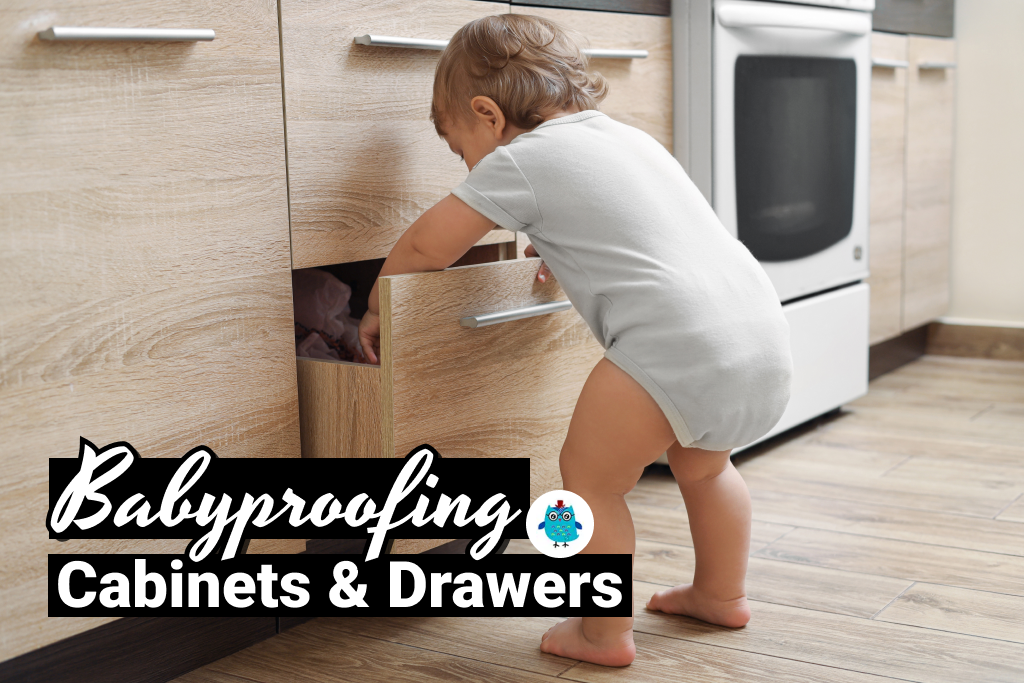A dad’s guide on how to babyproof your cabinets and drawers. Discover safety tips, child lock recommendations, and DIY solutions to childproof your kitchen.
I know firsthand how nerve-wracking it can be to babyproof your home for your first child. Especially when it comes to cabinets and drawers. From pinch fingers to more severe dangers, our cabinets, doors, and drawers can be a source of stress if not secure.
But don’t worry, I’ve got your back! In this guide, we’ll tackle the process of securing cabinets to ensure our curious kiddos don’t find any unwanted surprises.
This article will cover the following:
- Assessing Your Cabinets
- Choosing the Right Baby Proofing Products
- Additional Baby Proofing Tips for the Kitchen
- Conclusion
I’ll also share personal stories and product recommendations that will help you prevent accidents. So grab your safety goggles (just kidding!), and let’s start!
To fully proof your home, make sure you get the babyproofing equipment from this list!
Cabinet Safety Check: What to Look For
Before we start babyproofing, let’s look at the different types of cabinets you might have in your home. Make a note of any potential hazards like sharp edges or exposed hardware. Knowing the kind of cabinet you have will help you choose the most effective babyproofing method for each one.
Here’s a list of common areas where you should consider childproofing cabinets and drawers:
- Kitchen: The kitchen contains numerous hazards, such as cleaning supplies, sharp utensils, breakable items, and small appliances. Cabinets and drawers storing these items should be childproofed to prevent accidents.
- Bathroom: Childproof bathroom cabinets and drawers that store medications, cleaning supplies, toiletries, and personal care items like razors, which can be dangerous if accessed by children.
- Laundry Room: Cabinets and drawers in the laundry room often contain detergents, fabric softeners, and other potentially harmful chemicals.
- Home Office: Home office spaces may contain sharp objects like scissors or paper cutters, small office supplies like paper clips or staples, and electronic devices that could pose a risk to children.
- Garage or Workshop: If your garage or workshop has cabinets and drawers containing tools, chemicals, or other hazardous materials, it’s crucial to childproof them to prevent accidents. Moreover, these rooms should be gated, with special child locks on the door or by baby fences. For more information on baby gates, check out this guide I created.
- Living Room: Cabinets and drawers in these spaces may store small electronic devices with cords that can be choking hazards.
- Bedroom: Dressers and wardrobes in bedrooms may contain small items, such as jewelry or accessories, that can pose a choking hazard.
By identifying and childproofing cabinets and drawers in these areas of your home, you can create a safer environment for your little one to explore, grow, and learn.
What Types of Cabinets Do You Have?
Here’s a quick rundown of the most common cabinet styles. Remember, drawers and appliances are also crucial areas to babyproof.
- Standard Cabinets: These cabinets have doors that swing open on hinges, with a handle or knob on the outside. Think of the classic cabinet you’d find in most kitchens.
- Frameless Cabinets: Also known as “European-style” cabinets, these have no face frame, creating a sleek, modern look. The doors and drawers sit flush with the cabinet box, making it a bit trickier to babyproof.
- Corner Cabinets: These unique cabinets are designed to fit into a corner, usually with a door that opens on a hinge or slides out like a drawer.
- Cabinets with Glass Doors: While they may look fancy, they can pose a challenge regarding babyproofing. Not only do we need to secure the doors, but we also need to consider what’s visible and accessible through the glass.
- Sliding Door Cabinets: Instead of swinging open, these cabinet doors slide on a track, which can make babyproofing a bit more complex.
- Drawers: Found throughout the kitchen, bathroom, and other areas of your home, drawers can be a source of intrigue for your little one. From utensils and gadgets to cleaning supplies, they can contain various hazards, making babyproofing essential.
- Ovens and Stoves: These appliances can pose significant risks to curious kids.
- Refrigerators: This cold storage giant can be enticing for tiny hands.
- Dishwashers: The dishwasher is another must-secure appliance containing sharp utensils and cleaning chemicals.
- Microwaves: Often overlooked, microwaves can pose a risk if your child decides to investigate their contents or buttons.
I remember when my daughter started crawling, and I had no clue there were so many cabinet types!
How to Identify Potential Hazards?
Once we’ve figured out the types of cabinets, drawers, and appliances in our homes, it’s time to spot potential hazards lurking within. So, let’s put on our detective hats and uncover those hidden dangers!
- Assess Accessibility: Look at your cabinets from your child’s perspective. Can they climb, reach, or pull up using the cabinet doors or handles? If so, it’s essential to secure these areas.
- Look for Sharp Objects: From knives to food processors, sharp objects can pose a significant risk to curious kids.
- Check for Small Items: Tiny objects like batteries, magnets, and choking hazards should be kept away from little hands. My youngest once tried to swallow a button battery—scary stuff!
- Beware of Chemicals and Cleaning Supplies: Cleaning supplies and chemicals can be harmful or lethal if ingested.
- Mind the Glassware: Glassware can shatter and cause injuries.
- Spot Heavy Items: Heavy objects like pots and pans can cause injuries if pulled down by curious kids.
Now that we’ve identified our cabinets’ weaknesses let’s move on to choosing the right tools for the job.
Picking the Perfect Babyproofing Gear
With so many babyproofing products on the market, it’s easy to get overwhelmed. Fear not! I’ve researched and gathered the best options to suit every cabinet style. From magnetic locks to adhesive straps. I’ve put together a list of the most common types of child locks to help you make an informed decision.
What are the Different Types of Child Locks?
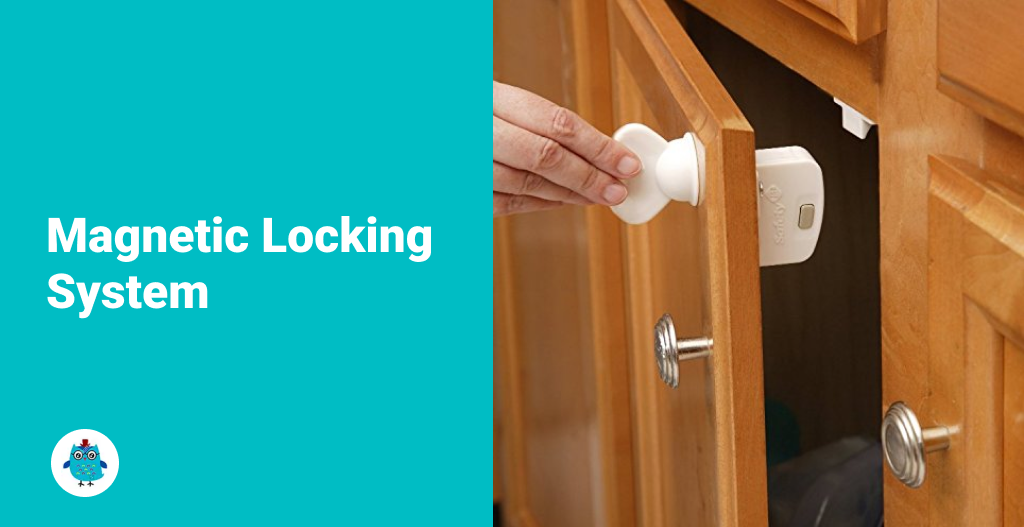
These smart locks use magnets to keep cabinet doors shut. A magnetic key is used to unlock them when needed. These are a great solution because they’re invisible from the outside, keeping our home looking tidy.
For more information, including price and shipping, check out the Safety 1st on Amazon here.
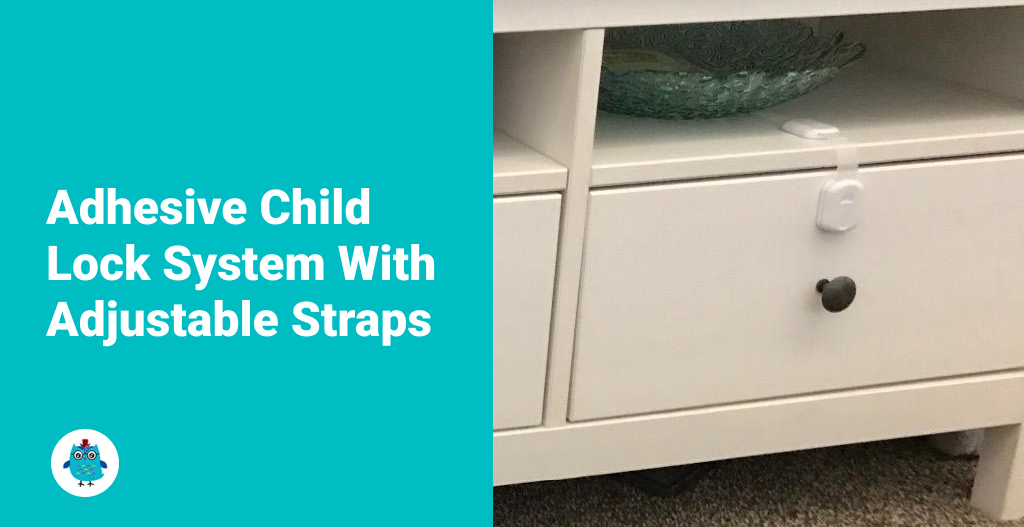
These versatile locks use adjustable straps to secure cabinet doors, drawers, and appliances. The straps attach to cabinet doors with strong adhesive, making them easy to install and remove without damaging surfaces. They’re a great option if you’re renting or prefer to avoid drilling into your cabinets.
For more information, including price and shipping, check out these Baby Safety Locks on Amazon here.

These U-shaped locks fit around cabinet handles or knobs, preventing the doors from opening. They’re easy to install and remove, making them popular among parents.
For more information, including price and shipping, check out the QT BABY on Amazon here.
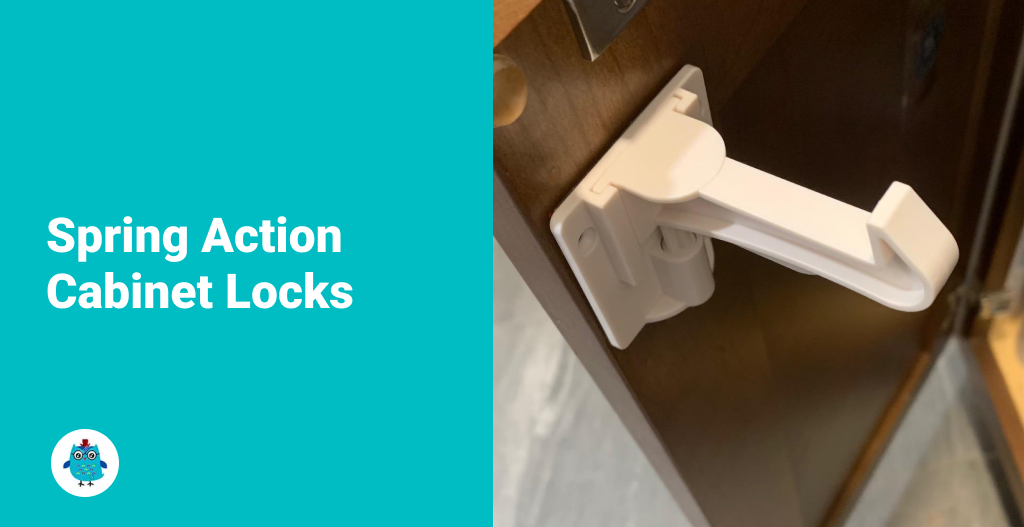
Installed inside the cabinet, these latches keep the door closed until you press down on a release mechanism. They require more effort to install but offer a more discreet option.
For more information, including price and shipping, check out these Spring Action Latches on Amazon here.
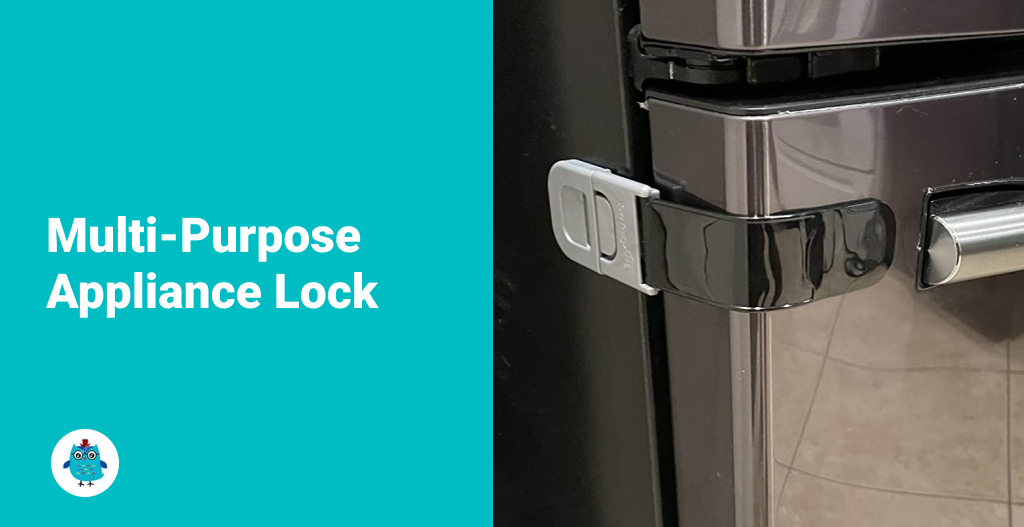
Designed specifically for appliances like ovens, refrigerators, and microwaves, these locks help prevent your child from accessing potentially dangerous items or accidentally turning on appliances.
For more information, including price and shipping, check out the Safety 1st on Amazon here.
How to Choose the Best Cabinet Locks for Your Needs?
- Consider Your Cabinet Types: As we discussed earlier, different cabinets require different locking mechanisms. Be sure to choose locks that are compatible with your cabinet styles.
- Ease of Installation: Some locks require drilling and screws, while others use adhesive or are tool-free. Consider your DIY skills and whether you’re comfortable with a more involved installation process or prefer a simpler, adhesive-based solution.
- Removability: If you’re renting or plan to move shortly, opt for removable locks that won’t damage your cabinets. Adhesive locks and strap locks are typically easy to remove without leaving a trace.
- Aesthetics: Some parents prefer discreet, hidden locks, while others don’t mind visible locks as long as they’re effective. Consider how important the appearance of your locks is to you and choose accordingly.
- Budget: While investing in safety is essential, consider your budget when choosing cabinet locks. Many affordable options are available, so don’t feel pressured to splurge on the most expensive ones.
When my wife and I were babyproofing our home, we opted for a mix of magnetic and adhesive locks based on our cabinet types and installation preferences. The key is to find the right balance between functionality, aesthetics, and ease of use, ensuring your home remains a safe haven for your little one.
Here’s the baby proofing I recommend.
| Area to Baby Proof | Ideal Type of Child Lock | Recommend Products |
|---|---|---|
| Standard Cabinet Doors | Spring Cabinet Locks | Spring Action Cabinet Locks |
| Frameless Cabinet Doors | Magnetic Locks | Safety 1st System |
| Cabinets with Knobs | Strap Locks | Baby Safety Locks |
| Drawer with Handles | Spring Cabinet Locks | Spring Action Cabinet Locks |
| Drawer without Handles | Magnetic Locks | Safety 1st System |
Are DIY Solutions Effective?
There are multiple reasons why you could consider going down the DIY road. Maybe your custom cabinets need a custom solution, or perhaps you are renting a home for vacation and need a temporary solution. I’ve also tried my fair share of DIY hacks, and let me tell you, the results can be a mixed bag.
I’ve learned that the effectiveness of DIY solutions largely depends on the materials used and the quality of the installation. For example, using rubber bands to close cabinet doors might work temporarily. However, a determined toddler can stretch, break, or easily remove them. On the other hand, designing your own cabinet locks using sturdy materials and hardware could be as effective as store-bought options.
If you’re considering DIY babyproofing solutions, here are the most important tips to keep in mind:
- Safety First: Always prioritize your child’s safety over aesthetics or convenience. If a DIY solution doesn’t provide the same level of security as a store-bought product, it’s best to invest in the latter.
- Test Thoroughly: Once you’ve implemented a DIY solution, test it rigorously to ensure it’s secure and effective. Put yourself in your child’s shoes and try to access the secured area.
When my eldest started crawling, I thought I could outsmart her by fashioning my own cabinet locks using string and hooks. While it worked briefly, she quickly figured out how to bypass my makeshift contraption. Lesson learned: sometimes, relying on expertly designed products is best to ensure our kids’ safety.
Now that your cabinets are secure let’s explore some additional babyproofing tips for the rest of your kitchen.
Beyond Cabinets: What to Keep in Mind When Storing Dangerous Items?
Child locks are a fantastic start to babyproofing your cabinets, but there’s more to consider when storing dangerous items. Cabinets and drawers are treasure troves of fascinating items for our little ones. As a father of two, I’ve learned the hard way that my little ones can be incredibly resourceful when exploring their surroundings.
Here are some essential tips for storing hazardous items beyond the child lock:
- Store Dangerous Items Out of Reach: It might seem obvious, but the higher you store harmful items like cleaning supplies, medications, and sharp objects, the safer your child will be. Aim for upper cabinets or shelves that are beyond your child’s reach.
- Regularly Inspect Locks: Set a schedule to check your child’s locks for any signs of wear or damage. Look for loose screws, weakened adhesives, or broken parts. This way, you can address any issues before they become a safety hazard.
- Install Baby Gates: Some rooms should be out of reach for small children. Consider installing baby gates to block access to the garage or basement.
- Label Everything: Label all hazardous items, including cleaning supplies, medications, and chemicals. This helps you stay organized and ensures that other caregivers or family members are aware of potential dangers.
- Keep Items in Original Packaging: Maintain medications and chemicals in original containers with safety caps and warning labels. This prevents confusion and makes it easier to identify potentially harmful substances.
- Re-evaluate as Your Child Grows: Their abilities and curiosity will change as your child grows. Regularly assess the effectiveness of your cabinet locks and consider upgrading or modifying them as needed to keep up with your child’s development.
- Supervise Your Child: No babyproofing solution is foolproof, so always keep a watchful eye on your little one when they’re exploring. It’s crucial to be vigilant and prepared to intervene if necessary.
Why You Shouldn’t Allow Your Child to See How to Unlock the Cabinets
Children are naturally curious and love to observe. While this curiosity is vital for their growth and development, it can sometimes lead to unintended consequences.
- Mimicking Behavior: If a child observes you unlocking a cabinet, they may attempt to mimic your actions, eventually figuring out how to bypass the child lock.
- Undermining the Purpose of Child Locks: If your child learns how to unlock the cabinets, it defeats the purpose of having child locks in the first place, putting their safety at risk.
- Encouraging Unsupervised Exploration: Once a child learns how to unlock cabinets, they may be more inclined to explore those areas when unsupervised, increasing the likelihood of accidents or injuries.
- Reinforcing Problem-Solving Skills: While it’s generally a good thing to encourage your child’s problem-solving abilities, you don’t want them to apply those skills to bypass safety measures. Keeping the unlocking process a secret helps ensure your child remains unaware of how to access off-limits areas.
How Can You Prevent Your Child from Seeing You Unlock Cabinets
Here are some strategies to prevent your child from observing you while unlocking cabinets:
- Distract Your Child: Before unlocking a cabinet, engage your child in an activity or provide them with a toy to keep their attention occupied. This will help divert their focus from your actions.
- Unlock Cabinets When Your Child is Not Around: Choose moments when your child is not in the room, such as during naptime or when playing in another area of the house, to unlock cabinets. Doing so reduces the chances of your child observing your actions.
- Be Discreet: Unlock cabinets discreetly and quickly, ensuring not to draw attention to your actions. Avoid making any noise or sudden movements that might pique your child’s curiosity.
- Position Yourself Strategically: When unlocking a cabinet, position yourself in a way that blocks your child’s line of sight. This could involve standing between your child and the cabinet or using your body to shield the unlocking process.
- Communicate with Other Caregivers: Make sure all caregivers in the household, such as spouses or babysitters, know the importance of keeping the unlocking process hidden from your child. Consistency is key to maintaining the effectiveness of child locks.
This made me think about my youngest when she caught me unlocking a cabinet containing cleaning supplies. The next thing I knew, she tried to replicate my actions with her little fingers. That was a reminder for me to be more discreet when unlocking cabinets.
Remember, babyproofing goes beyond simply installing child locks. Being proactive about storing dangerous items and maintaining a safe environment is crucial for your child’s safety.
Mission Accomplished
By following these tips, and investing in the right products, you’re on your way to creating a safe home for your child to explore. Being proactive about babyproofing gives us peace of mind we need to take on the other challenge of parenting.
We can help our children navigate their world safely with a little effort and diligence.
So, Keep up the good work! and babyproof like a pro!

